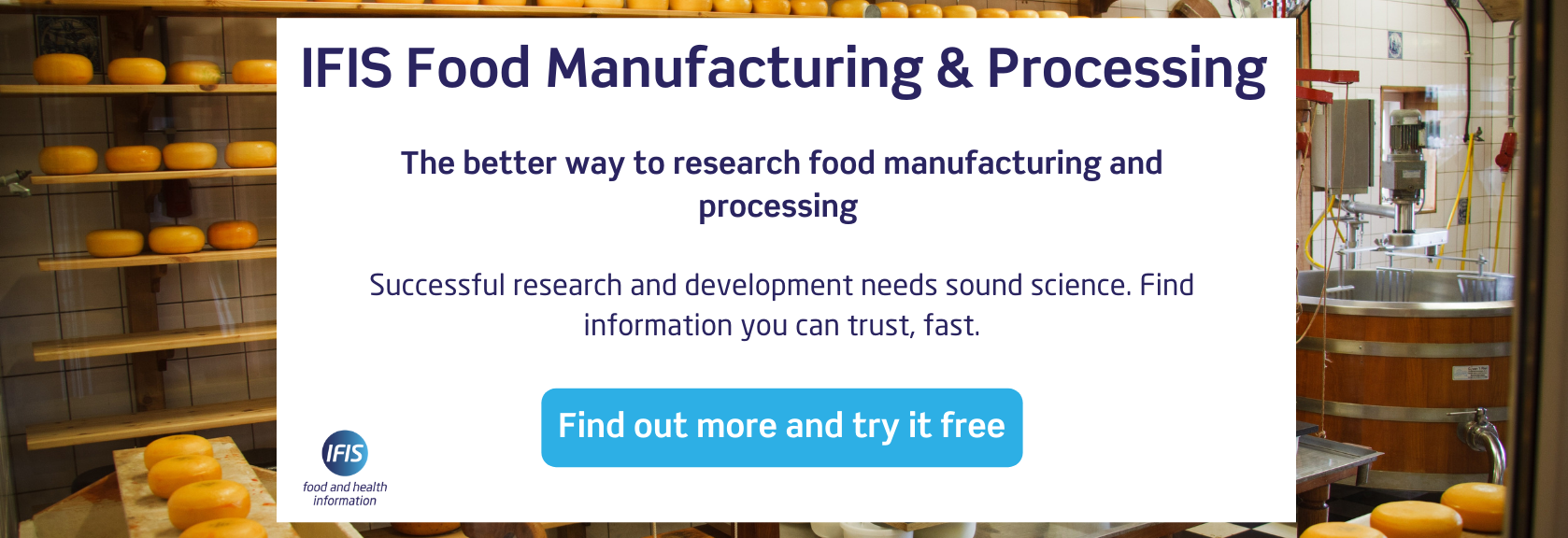Are ultra-processed foods (UPFs) indeed nutritionally inferior, and if not, do they really need to be avoided as NOVA claim?
An overview of IFST's fantastic lecture: ‘Ultra-processed foods: the science and the policy’, delving into the complexities and conflicts surrounding the often misunderstood topic area of UPFs, delivered by The audience gathered to hear former president of the Nutrition Society and current Director of University College Dublin (UCD) Institute of Food and Health and Professor of Food and Health at UCD, Professor Michael Gibney MAgrSc, MA, PhD, deliver a thought-provoking presentation depicting his personal, yet evidence-based opinions on the broad topic of ultra-processed foods.
So what is an ‘ultra-processed food’? When it comes to defining the term, there appears to be little consistency in the literature, and as such it has largely been open to interpretation. This has led to inevitable confusion among both health professionals and the general public as to what foods fall under this category, their possible health implications and whether or not they should be avoided/restricted in the diet. The general approach of the NOVA food classification is to place foods into four broad food categories dependant on the degree of processing the food has undergone; 1) unprocessed or minimally processed foods, 2) processed culinary ingredients, 3) processed foods, and 4) ultra-processed foods and drinks (UPFs). The NOVA classification also considers the purpose of the processes and ingredients used to manufacture the end product, which among others include extending shelf-life, increasing profitability, enhancing palatability and developing ready-to-eat convenience foods. Example of typical UPFs that fall under this category include margarines and spreads, fruit yoghurts and fruit drinks, breakfast cereals and instant soups, noodles and desserts.
 The controversy arises when these devised categories are used to infer that by attempting to make the UPFs ‘hyper-palatable’, they are inherently higher in salt, added sugar, fat and additives due to the modifications they have undergone in processing, and therefore consuming foods in this category put consumers at a greater risk of obesity and its co-morbidities including type 2 diabetes mellitus, cardiovascular disease (CVD) and heart disease, as well as some cancers. As Professor Gibney explained, this approach notably contradicts established healthy eating advice which instead recognises the nutritional profile of an overall diet and dietary pattern, rather than the degree of processing of a specific food item, as the most critical factor in determining optimal health.
The controversy arises when these devised categories are used to infer that by attempting to make the UPFs ‘hyper-palatable’, they are inherently higher in salt, added sugar, fat and additives due to the modifications they have undergone in processing, and therefore consuming foods in this category put consumers at a greater risk of obesity and its co-morbidities including type 2 diabetes mellitus, cardiovascular disease (CVD) and heart disease, as well as some cancers. As Professor Gibney explained, this approach notably contradicts established healthy eating advice which instead recognises the nutritional profile of an overall diet and dietary pattern, rather than the degree of processing of a specific food item, as the most critical factor in determining optimal health.
The public health nutrition advice of NOVA arising from their definition is that UPFs should be avoided to achieve improvements in nutrient intakes, with an emphasis on fat, sugar, and salt. This message is often propelled further by hyperbolic headlines in the media which single out specific UPFs, often stigmatised as cheap, fat and sugar dense convenience foods targeted at time-poor consumers, as direct risk factors for chronic disease. However, considering that NOVA classification of UPFs constitutes over half the daily energy intake (EI) of populations in developed economies, in reality is this recommendation sensible, necessary or even feasible? Michael Gibney suggests that it's a topic worthy of further debate.
The key question explored in the lecture was whether UPFs are indeed nutritionally inferior, and if not, do they really need to be avoided as NOVA claim? In terms of sugar, research does indicate a linear relationship between consumption of UPFs and intake of added sugars, with a large cross-sectional study finding that UPFs contributed 89.7% of EI from added sugars in the USA (Steele et al., 2016). However when examined further, of the 16 food groups listed as sources of added sugars from UPFs, 2 stood out above the rest as contributing the most to added sugar intake; sugar-sweetened beverages and fruit drinks contributed 17.1% and 13.9% % of EI from added sugars respectively. In fact some food groups listed as UPFs contributed as little as 0.7%, as was the case for salty snacks, therefore wouldn’t a public health nutrition strategy that tackled sugar laden drinks be a more cost-effective, sensible approach, rather than targeting an entire food category, which in itself could create a multitude of problems for policy makers?
Some studies have suggested that due to the modifications involved in processing, UPFs can often be alarmingly high in certain macro- or micro nutrients deemed to be potentially damaging to human health, or conversely depleted of vital health-promoting nutrients and minerals. However, Professor Gibney argues that although this may often be true for added sugar and reduced fibre content, for all other nutrients the scientific evidence doesn’t stack up. When reviewing a number of studies undertaken using samples of the population in the UK, Brazil, Canada and the US, in which the primary aim was to assess the contribution of ultra-processed foods in the diet and their association with the overall dietary content of nutrients known to affect the risk of chronic non-communicable diseases (NCDs), no causal link could be firmly established between the quintile of intake of ultra-processed foods and total fat % and SFA % of total EI or sodium g/1000 kcal, with Brazil, Canada and the US managing to meet or exceed the WHO target for sodium intake of 2g/d at even the lowest quintile of UPF intake. Professor Gibney suggests that there is no clear biological basis to believe that either processing or additives are linked to the development of chronic disease and processing level is a minor determinant of an individual food’s nutrient contribution to the diet.
Therefore, the perception that all ultra-processed foods are inherently high in unhealthy fats and salt and are therefore significant risk factors for chronic disease appears largely unfounded. The same can be said for the addition of additives, including TiO2, Nitrosamines, Acrylamide and Bisphenol A, in which studies have used phrases such as ‘has been questioned’, ‘suggests there could be’ and ‘it is possible’ to spark concern, however these assumptions are often unhelpful, contradict the views of EFSA and are largely unsupported by science.
Instead of avoiding UPFs in their entirety, Public Health England have proposed that both reducing portion size and encouraging reformation of foods high in fat and sugar content is an achievable method that should be considered to improve nutritional profiles and consumers’ nutrient intake, however NOVA refute this idea of reformation as unhelpful, as inherently unhealthy products are only made somewhat less unhealthy due to manipulation of their constituents, and instead recommends that healthier choices be made from the beginning.

However, as Professor Gibney observes, in today’s busy and time-pressured society, it is farcical to believe that the ‘ideal’ scenario in which consumers prepare home cooked meals with entirely unprocessed ingredients every day is practical, and it is inevitable that choosing convenience foods every now and again- ultra-processed or not- often trumps the alternative, with minimal adverse health consequences. It is also notable that from a food science perspective, some products that consumers may perceive to be largely unprocessed, such as dark chocolate and olive oil, are in fact often no less processed than some ultra-processed classified foods; another reason why a holistic approach to public health nutrition advice should be considered.
 In one of his concluding statements, Professor Gibney drew the audience’s attention to his own typical breakfast routine, consisting of instant porridge, 0% fat vanilla yogurt, pre-packaged wholemeal bread, light margarine and tea with low fat milk. Speaking in jest, he emphasised that what appeared to be a healthy, balanced breakfast was seemingly far from it when assessed though the critical lens of ultra-processed food identification, with nearly all components of the breakfast falling into the heavily scrutinized 4th category. The irony is that most of these items have been ultra-processed in order to create foods with considerable benefit to the consumer, whether that be in terms of health, convenience or cost.
In one of his concluding statements, Professor Gibney drew the audience’s attention to his own typical breakfast routine, consisting of instant porridge, 0% fat vanilla yogurt, pre-packaged wholemeal bread, light margarine and tea with low fat milk. Speaking in jest, he emphasised that what appeared to be a healthy, balanced breakfast was seemingly far from it when assessed though the critical lens of ultra-processed food identification, with nearly all components of the breakfast falling into the heavily scrutinized 4th category. The irony is that most of these items have been ultra-processed in order to create foods with considerable benefit to the consumer, whether that be in terms of health, convenience or cost.
Therefore, perhaps less focus should be placed on whether or not an individual food is ultra-processed, and instead more attention given to diet quality as a whole; a concept that has formed the frame work of gold standard nutritional advice for decades. It is argued that using the umbrella term ‘ultra-processed foods’ can tarnish the reputation of foods specifically developed to optimise public health, as it should be considered that a food product that has undergone one or more processes, such as the addition of emulsifiers, does not automatically make the food unhealthy. One such example of this is the case of margarine vs butter. Public debate surrounding which spread is superior in terms of health benefits has raged for years, with many consumers perceiving margarine as an artificial type of unsaturated fat because of the complex and intensive processes required in its development. However, evidence-based science going back to the 1960’s shows that butter consumption directly affects cholesterol levels, raising total and LDL cholesterol and therefore contributing to atherosclerosis; a prominent risk factor in the development of heart disease and CVD. So although there are undeniably more processes undertaken in margarine’s manufacturer compared to butter, this does not make butter a ‘health food’ and the positives of choosing margarine in terms of long-term heart health may predominantly outweigh the negatives.
References
Contribution of highly industrially processed foods to the nutrient intakes and patterns of middle-aged populations in the European Prospective Investigation into Cancer and Nutrition study. European Journal of Clinical Nutrition Volume: 63 Supplement: 4 Pages: S206–S225. Published 2009
FSTA: 2010-02-Aj0645
Contributions of processed foods to dietary intake in the US from 2003–2008: a report of the Food and Nutrition Science Solutions Joint Task Force of the Academy of Nutrition and Dietetics, American Society for Nutrition, Institute of Food Technologists, and International Food Information Council.
Journal of Nutrition Volume: 142 Issue: 11 Pages: 2065S–2072S. Published 2012
FSTA: 2013-01-Ge0146
Ultra-processed foods and added sugars in the US diet: evidence from a nationally representative cross-sectional study
BMJ Open Volume: 6 Issue: 3 Pages: e009892. Published 2016
Ultra-processed foods: definitions and policy issues.
Current Developments in Nutrition Volume: 3 Issue: 2 Pages: nzy077 Published 2019
FSTA: 2019-08-Ge4354
Ultra-processed foods: what they are and how to identify them.
Public Health Nutrition Volume: 22 Issue: 5 Pages: 936–941 Published 2019.
FSTA: 2019-07-Ge3929
Images used with permission from Unsplash.com and Pixabay.com


